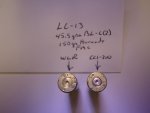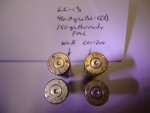I've been trying to arrive at a good SHTF load that won't break the bank, are easy to load and supply reasonable accuracy and are within safe pressure limits. I have a boat load of Hornady 150 gr FMC bullet heads and LC-13 once fired brass. I've settled on BL-C(2) and Winchester LR primers. (I know this component combo isn't going to make match grade ammo but that is not really what I'm interested in). I've been chronographing charge weights between 44.0 and 47.0 grs in an Armalite AR-10 /w 20" chrome lined barrel. I did my velocity testing on an 85 degree day leaving the ammo in the sun on my truck's dashboard ( which was around 100 degrees) to get a idea of how the loads perform at higher temperature.
What really impressed me was how flattened the Winchester primers were (they are the gold color ones). I'm thinking that based on the appearance of the WLR primers I'm about at or past a safe pressure. As for other indicators: there were no ejector imprints in the case heads and all of these fired cases would easily drop in and out of a Wilson cartridge headspace gauge. Also I tried these loads at the same time in a Rem 700 PSS that exhibited no difficulty with bolt lift or extraction until I reached 47.0 grs and bolt lift was a little sticky.
I also loaded up some of the 45.5 gr and 46.0 gr loads with CCI-200 primers. These primers didn't exhibit the flattening that the WLR primers did; in fact the CCI-200 primers still retained a radius around there perimeter. See the attached photos of the primers in the 45.5 gr and 46.0 gr loads.
The velocities with 45.5 gr loads for both the WLR and CCI-200 primers were 2729 fps; the velocity for the 46.0 gr load with the WLR primer was 2739 fps and the 46.0 gr load with the CCI-200 clocked at 2743 fps. All these velocities were an average for 10 rounds with the chronograph 15' from the muzzle.
Based on the appearance of the 46.0 gr load with the CCI-200 primer plus the other indicators do you more experienced gas gun shooters think pressure wise this is a safe load?

What really impressed me was how flattened the Winchester primers were (they are the gold color ones). I'm thinking that based on the appearance of the WLR primers I'm about at or past a safe pressure. As for other indicators: there were no ejector imprints in the case heads and all of these fired cases would easily drop in and out of a Wilson cartridge headspace gauge. Also I tried these loads at the same time in a Rem 700 PSS that exhibited no difficulty with bolt lift or extraction until I reached 47.0 grs and bolt lift was a little sticky.
I also loaded up some of the 45.5 gr and 46.0 gr loads with CCI-200 primers. These primers didn't exhibit the flattening that the WLR primers did; in fact the CCI-200 primers still retained a radius around there perimeter. See the attached photos of the primers in the 45.5 gr and 46.0 gr loads.
The velocities with 45.5 gr loads for both the WLR and CCI-200 primers were 2729 fps; the velocity for the 46.0 gr load with the WLR primer was 2739 fps and the 46.0 gr load with the CCI-200 clocked at 2743 fps. All these velocities were an average for 10 rounds with the chronograph 15' from the muzzle.
Based on the appearance of the 46.0 gr load with the CCI-200 primer plus the other indicators do you more experienced gas gun shooters think pressure wise this is a safe load?



